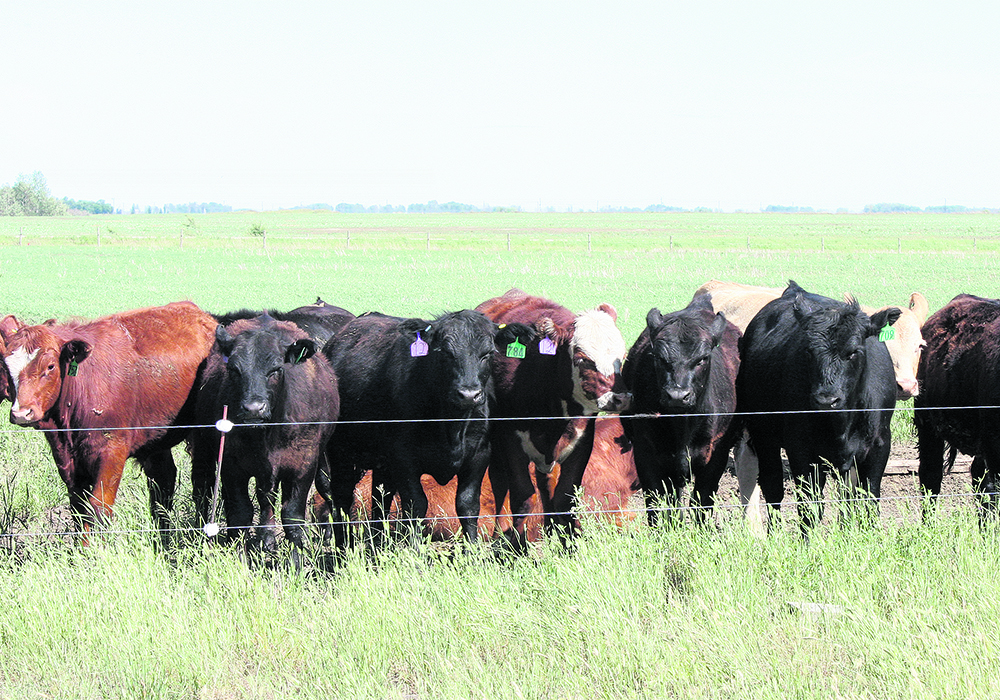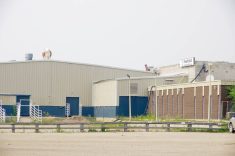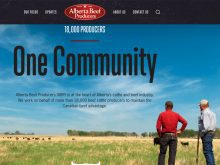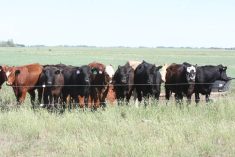Despite high cattle prices, there are few signs that producers are preparing to increase the size of their herds
Glacier FarmMedia – High calf prices have been a good news story for cow-calf producers, but they’ve done little to help Canada recover its diminished beef herd.
“According to Statistics Canada, we’ve seen a decrease in total cattle inventories in Alberta from 5.225 million on July 1, 2023 to 5.145 million on the same date this year,” said Alberta Beef Producers chair Brodie Haugan. “There are a number of factors at play here, including the recent, widespread drought and good prices for livestock.”
Rick Wright, executive administrator of the Livestock Markets Association of Canada, said it’s a trend he’s seeing across Western Canada.

“By the time we get the numbers in, in December, we’ll probably see another decrease in the number of beef cows,” he said. “We have a number of producers that are close to retirement age that have made peace with the taxman, and they’re dispersing their cows this fall.”
Read Also

House ag committee to undertake several studies
The House of Commons standing agriculture committee has set its agenda for the coming months. Members began the fall sitting with a two-hour update on international trade
Instead of incentivizing producers to rebuild herds, however, anecdotal reports indicate a surge of producers left the business in recent years.
Official cattle numbers have also slid, helped along by the 2021 drought. There’s been no evidence of a recovery to date. From 2021 to 2024, the number of cattle on Prairie beef farms dropped by 650,000 head, or 7.3 per cent from a total of 8.89 million in 2021 to 8.24 million this July.
National numbers reflect the same decline. Statistics Canada put Canada’s beef herd at just over 10.777 million in 2021. In 2024, the estimated beef herd was 10.079 million.
In terms of proportional hit to the beef herd, Manitoba led the way. Although it has less cattle than the western Prairies, the Manitoba beef herd dropped 12.3 per cent from 2021-2024, from 1.006 million to 882,600. That outpaces Saskatchewan, which dropped eight per cent in the same window, from about 2.602 million to just under 2.393 million.
Alberta topped the Prairies in terms of total beef animals lost (317,200 head from 2021-2024) but, as the biggest beef cattle-growing province of the three, that translated to a six per cent hit to the total beef herd, from just under 5.284 million to just over 4.966 million.
“This is an unheard of scenario,” said Matthew Atkinson, president of Manitoba Beef Producers. “We have record cattle prices, relatively cheap money (low interest rates), and we also have low feed costs and an abundance of feed.”
Atkinson said he is shocked by the number of herd dispersals, even from big, diversified herds. He cited one recent conversation with an auction mart manager. The auction had fielded only one call from a person looking for cows, but a steady stream of herd dispersals booked for the fall.
“That’s really disappointing,” Atkinson said. “Because everybody’s really wanted this higher price; they wanted to be profitable; they wanted all of this. And now that it’s here, everybody’s getting out.”
That disappointment is shared by the Saskatchewan Cattlemen’s Association. Chief executive officer Grant McLellan said farmers haven’t yet reached the level of comfort needed to regrow the herd.
“Producers are still a bit shell shocked over the past number of years,” he said. “They’re still hesitant to move back to a market that’s been challenged by drought for better half last decade.”
Demographics are also affecting the industry’s mood, he added.
“Lots of folks are retirement age and there’s probably not a better time than they’ve ever seen in their lifetime to move out of the business.”
Summer prices have been high, and Wright said producers have been agressively weeding out animals to sell. While the herd decrease might not be as big as it was last year, when drought was hammering harder at the western Prairies, he doesn’t see a turnaround in the near future.
Heifer price is also quite strong, and that is putting downward pressure on heifer retention.
“It’s pretty tempting for these producers to sell those heifers and turn them into cash flow, and so we’re not seeing heifer retention like we have done in other years,” Wright said.
Most of the Prairies have better forage amounts than in the previous two years. That has lowered the strain of purchased feed costs and potential shortages.
The abundance of feed, combined with strong calf prices promising profit, could ease the pressure to send cattle to market.
“We could see a bit of a correction coming before Christmas time, but certainly, the cow-calf guys are in the driver’s seat again this year and are going to get good returns, and that should encourage guys to take a look at getting their numbers back up,” Wright said.
That’s likely not going to be enough to move the needle on the national herd size in the short term, he cautioned, nor is it enough for American farmers, who suffered many of the same weather stresses as Canadian ranches and are also facing their smallest herd in decades, to start expanding again.
“We haven’t hit the rebuild cycle there yet,” said Wright. “In the cattle cycle, we’re probably at or close to the bottom, and if everything stays true to history, we should start to regain, but I think that this is going to get stretched out a little bit longer than what a lot of people think.”
He estimates that recovery is at least another year away.
That’s partly because of stubbornly high land prices, he argued.
“It’s hard to buy land that you can afford to put cattle on, and that’s been a limiting factor as well. And even though the grain seems to be on the down slide right now, it hasn’t affected the land prices. They’re still very strong,” Wright said.
McLellan is less optomistic than Wright in terms of the recovery timeline. He said he’s expecting to wait three to five years before the herd rebounds.
“This regrowth of the industry is going to require a couple of things. One is that meat prices continue to be stable again and at a more reasonable level than they’ve been in the past,” he said. “And the second thing is, of course, moisture. That is always going to predict how our industry is going to go.”
While beef cattle prices have been slow to deflate, Wright noted that the prospect of a sudden market dip has some producers wary.
“The last time we had a real good bump, it lasted for about 14 months and then we had a major correction. There is a lot of anxiety out there with producers right now as to when the next correction is coming.”
That anxiety isn’t misplaced, he added. There are signs that a correction might already be underway.
“Right now, the harvest price from the packing plants looks like it’s peaked,” he said. “It’s actually dropped considerably here, in the last couple of months.”
And while the export market has been good for beef and demand remains high, Wright says that market may also be close to peaking.
“One of the things that’s going to offset the meat market (demand) is this beef on dairy program we’ve seen become more prevalent over the last 18 months, especially in the US. Animals that can be fed and put into the meat program are going to produce a lot more pounds of beef. So, we may be short of cattle as far as beef cattle goes, but we won’t be as short of meat.”
Carcass weights also favour beef supply.
“While there are fewer animals, it’s important to note that both the U.S. and Canada saw larger carcass weights this year,” said Haugan. “This helps offset some of the herd number changes when it comes to total beef supply.”
If that export market has peaked, Wright said the only thing keeping feeder cattle at their current high prices is the prospect of cheaper feed in the fall.

Atkinson said that better and more affordable business risk management tools would reduce producer anxiety.
That has been a long-time ask of the beef sector. Both provincial and federal industry groups have argued that beef does not have the same publicly supported insurance options as the grain industry, where AgriInsurance premiums are cost-shared with government.
“We have things like livestock price insurance (LPI), but we’ve seen our neighbours to the south go to a cost share on it, like we see with crop insurance, and the uptake on it is amazing,” said Atkinson. “LPI is a great program, but a big chunk of the profit on those calves is taken out to enrol in it.”
The program, which is designed to protect farmers against market volatility, insures calves to a base price and pays out should the market fall below that insured price.
Haugan said Alberta Beef Producers is seeing movement in its calls for equitable business risk management.
“We are hopeful the AgriStability pilot provides meaningful improvements,” he said. “AFSC (Agriculture Financial Services Corp.) recently announced changes that will support new and young entrants to the industry through the Next Generation Loan.”
That program is designed to offer eligible producers with fixed-rate term loans under repayment terms more friendly to farm cash flow and “an option of up to five years of interest-only payments,” according to the corporation’s website.


















